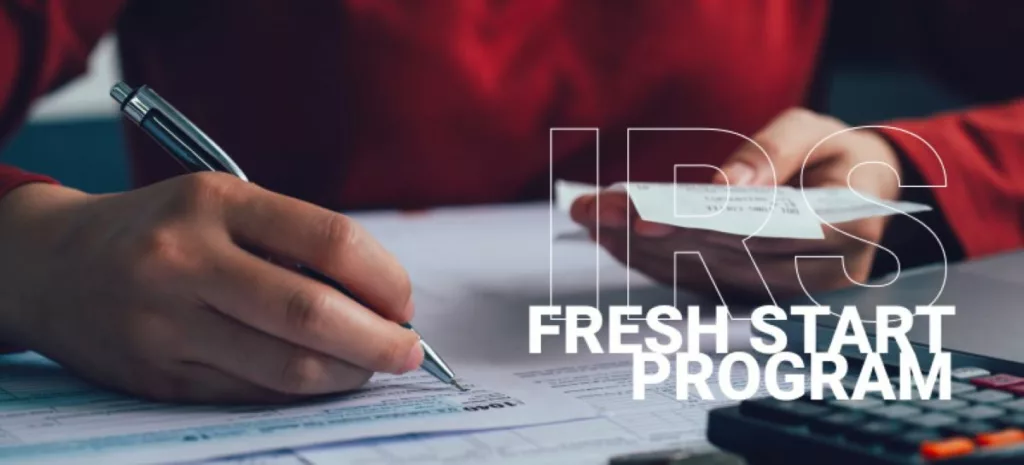Having a solid financial plan is important, but unexpected situations can still leave you unable to pay your taxes when the filing deadline arrives. If you find yourself in this position, it’s important to know you’re not alone. The government recognizes that unforeseen challenges can lead to unpaid federal taxes, which is why the IRS created the Fresh Start Program. Keep reading to find out the details of the program, including how it works, who qualifies, and how to apply, so you can navigate the process with confidence.

- What Is IRS Fresh Start?
- How Does the Fresh Start Initiative Work?
- Who Is Eligible for the IRS Fresh Start Program?
- How To Apply for the IRS Debt Program
- What Is the Processing Time for IRS Fresh Start?
- What Is the Application Deadline?
- Manage and Reduce Tax Debts Using IRS Fresh Start
What Is IRS Fresh Start?
The IRS Fresh Start Program is a federal initiative designed to assist Americans who are unable to pay part or all of their taxes. Launched in 2011, this program aims to help individuals and businesses manage tax debt, obtain relief, and avoid IRS tax liens. Whether due to financial hardship or other circumstances, the Fresh Start Program offers a pathway to repay taxes more affordably and regain financial stability.
How Does the Fresh Start Initiative Work?
The IRS Fresh Start Program is a nationwide tax relief initiative managed by the Internal Revenue Service (IRS). It provides taxpayers with a more flexible and manageable way to resolve their tax debt, whether they can only pay a portion of the balance or are unable to pay at all.
The relief options the IRS offers through the program include:
- Payment plans or installment payment agreements
- Lenient penalty and tax lien relief
- The IRS offer in compromise (OIC) to ultimately pay your tax debt for an amount lesser than you owe.
- A temporary delay collection to pause your repayment for a while if you can’t afford to pay immediately or you’re in bankruptcy.
You’re probably asking, “How do I get my IRS debt forgiven?” Qualifying for IRS debt forgiveness is possible through one of the relief programs linked to the Fresh Start initiative. However, each program has its own set of specific terms, conditions, and required documentation that must be met to qualify for tax debt forgiveness.
While there are no strict deadlines for the IRS Fresh Start programs, it’s essential to note that individuals typically need to agree to repay their outstanding tax debt within 60 months, while business owners generally have up to 34 months to settle their liabilities.
You may also be interested in learn what tax relief is available for those divorced or separated.
Who Is Eligible for the IRS Fresh Start Program?
Each part of the IRS Fresh Start Program has unique eligibility requirements, such as the maximum debt amount and whether the taxpayer is an individual or a business. However, individual taxpayers must meet certain general criteria before selecting a specific relief option. For 2024, the eligibility requirements for individuals under the Fresh Start Program include the following:
- Being self-employed with an income that has fallen by at least 25%
- Being single and earning less than $100,000
- Being married with an income lower than $200,000
- Having a tax debt balance below $50,000 in combined tax, penalties, and interest
- Falling behind on any IRS tax payment for the first time
- You have an up-to-date tax filing record with all tax payments for the application year
- You have no ongoing bankruptcy proceedings
- Agreeing to completely pay up your outstanding debt within 60 months
As an entrepreneur, you must meet the requirements below to qualify:
- Have federal tax filings and payments that are up-to-date as of the time of application
- Owe the IRS less than $25,000 in combined tax, penalties, and interest
- Falling behind on an IRS tax payment for the first time
- Being able to completely pay up your company’s outstanding debt within 34 months
Note that the IRS will not offer you an OIC if they are convinced you can pay your tax debt through alternative options like an installment plan or a payment agreement.
How To Apply for the IRS Debt Program
After reviewing the IRS guidelines, you can apply for the IRS forgiveness program using the Online Payment Agreement Tool or the IRS Installment Agreement Form 9465.
After filling out the online application, you can upload the supporting documents using the IRS Document Upload Tool. These include detailed bank statements, evidence of filed tax returns, and other supporting documents like a medical record for penalty abatement due to illness.
If you’re considering other relief options like the OIC, you’ll need to apply using the Offer in Compromise Pre-Qualifier Tool. However, for a successful OIC application, you must make an initial payment of 20% of the total offer amount you received in your initial application report.
What Is the Processing Time for IRS Fresh Start?
The application process can be rigorous and time-consuming, with an average review and application period of 30 days to 12 months, depending on your preferred relief choice. If you need help, have questions, or disagree with your tax bill information, you can contact your local IRS office or find a taxpayer assistance center near you.
What Is the Application Deadline?
The IRS Fresh Start Program runs throughout the year, so there’s no specific application deadline. However, individual relief options may have specific application periods. For example, the Fresh Start deadline for the student loan fresh start is September 30, 2024.
Can I Negotiate With the IRS Myself?
You can enter an IRS tax debt negotiation yourself and apply for an OIC, installment agreement or penalty abatement. However, you can strengthen your application by getting tax professionals with previous experience and a successful track record working with the IRS.
Manage and Reduce Tax Debts Using IRS Fresh Start
Individual taxpayers and entrepreneurs in California who are struggling financially or have outstanding tax debts due to medical challenges can maximise the Fresh Start Program to repay IRS tax debts.
The program offers various tax relief options, including the installment payment agreement, the offer in compromise, and deferred payments through the Currently Not Collectible (CNC) initiative. While you can apply for any of the collective program reliefs, you can speak to a professional if unsure, overwhelmed, or inexperienced.





